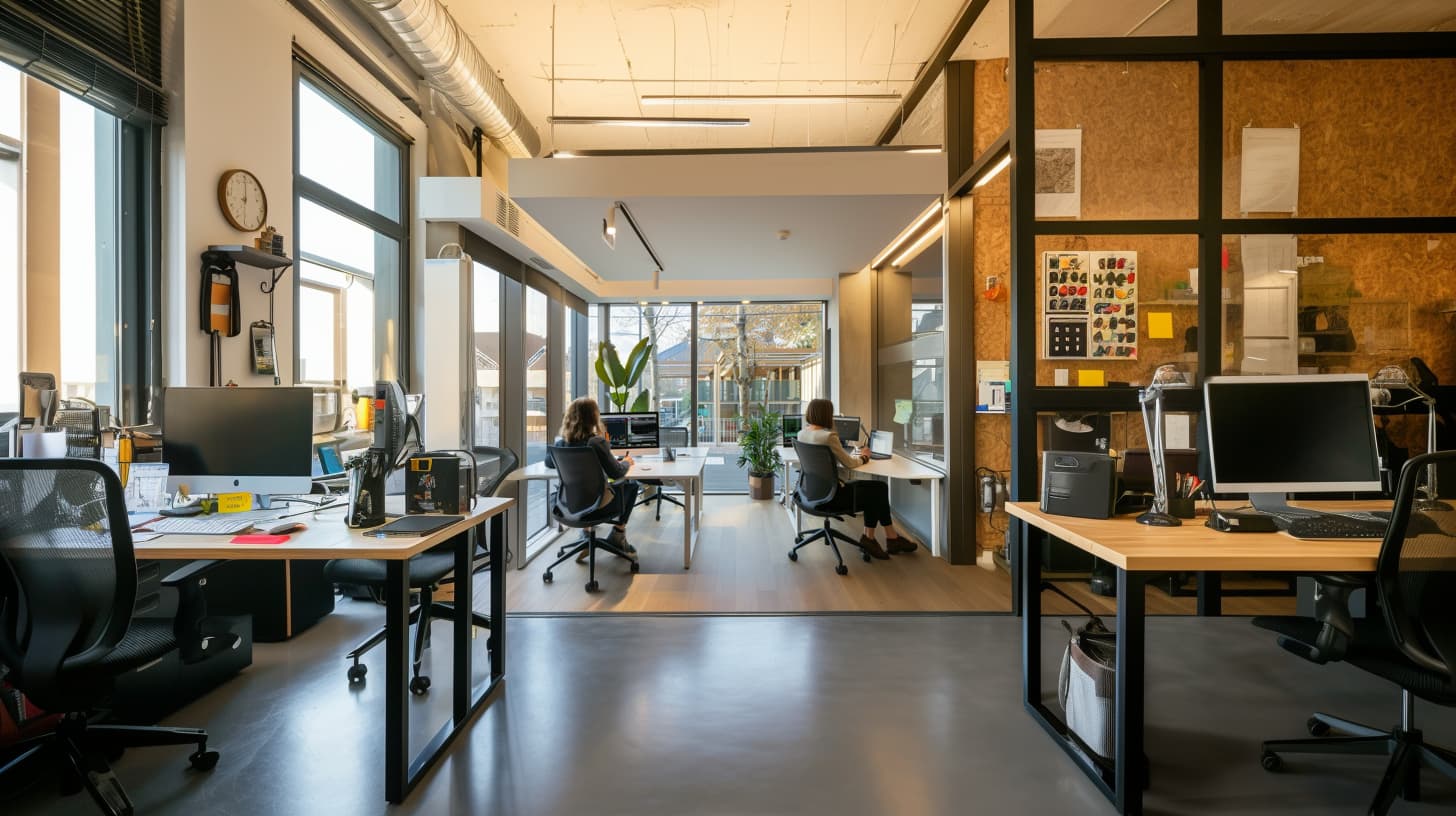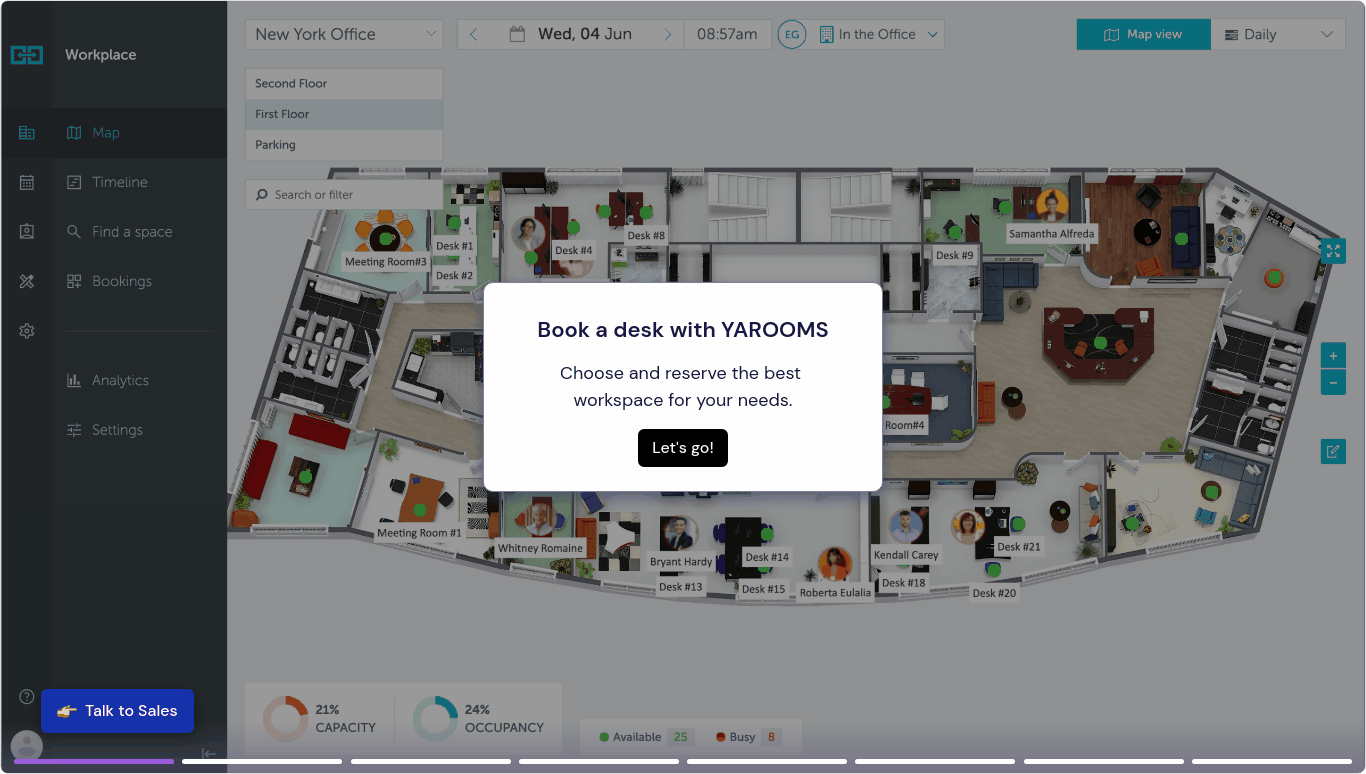Planning an office layout can often feel like solving a Rubik's cube. You're faced with many factors, from space limitations to employee preferences and an ever-present concern for cost and resource optimization. However, one solution that can help unravel this complexity is calculating your desk-sharing ratio. This handy number can guide you toward an optimal workplace design that balances efficiency and comfort.
TL;DR:
- Desk sharing ratio, a key concept in workplace management, defines the proportion between employees and available desks, crucial for companies with flexible work schedules or hot desking policies.
- Calculating this ratio requires considering factors like office layout, desk availability, remote work arrangements, employee schedules, and organizational growth plans.
- An optimal desk sharing ratio improves workspace management by aligning with employee preferences, enhancing flexibility, optimizing resource allocation, and designing functional layouts.
- Calculating the ratio involves simple math but must consider work patterns, space utilization, and the employee experience to ensure productivity and satisfaction.
- No universal "optimal" desk sharing ratio exists; it varies by company, reflecting work nature, culture, and the extent of remote or flexible work arrangements.
- Achieving an optimal ratio for your organization involves trial, evaluation, flexible space planning, and technology support to adapt to changing needs and preferences.
- Technology plays a crucial role in maintaining efficient desk sharing ratios through space management software, mobile apps, and sensor technology for real-time workspace usage insights.
- Properly calculated, desk sharing ratios can enhance workspace efficiency, flexibility, and productivity, reflecting the adage that every system is perfectly designed to get the results it gets.
What Is a Desk Sharing Ratio?
Let's begin by defining our primary subject. The desk sharing ratio, often used in workplace management and office space planning, refers to the proportion between the number of employees and the number of desks available in an office space. This ratio is particularly relevant in environments where not every employee is expected to be in the office simultaneously, such as in companies with flexible work schedules, remote work options, or hot desking policies, where desks are used on an as-needed basis rather than permanently assigned to specific employees.
The desk sharing ratio provides crucial information about how well your current office setup caters to employees' emerging needs while efficiently balancing company resources. Understanding your company's unique desk sharing ratio paves the way for establishing smarter workplace strategies focused on productivity, flexibility, and sustainability.

Factors Influencing the Calculation of Desk Sharing Ratio
Undeniably, calculating the optimal desk sharing ratio involves meticulous factoring of different variables. It often requires a multi-faceted approach to accurately reflect your company's unique needs and work environment.
Office Layout and Desk Availability
Firstly, the physical office layout plays an essential role in deciding the desk sharing ratio. A wide-open office with ample communal spaces might support higher employee:desk ratios than a more compartmentalized and private setting. Additionally, the total number of desks available would directly impact how many employees can share workstations.
Remote Work Arrangements
Remote work practices also significantly affect the calculation. If a considerable percentage of your workforce operates remotely or is adopting a hybrid model (splitting their time between home and office), fewer desks may be needed overall.
Employee Shift Schedules
Work schedules also greatly influence this equation. For example, if you operate in shifts or flexible working hours, more employees can use the same desks at different times. Trying to accommodate all employees at once results in unnecessary resource waste when certain desks remain underutilized during specific periods.
Organizational Growth and Scalability
Future growth plans and workforce scalability should be considered when calculating the desk sharing ratio. A company expecting to grow rapidly might plan for lower desk sharing ratios to accommodate new hires without the immediate need for additional office space. Conversely, a stable or downsizing workforce might opt for higher ratios.
Advantages of Calculating Your Desk Sharing Ratio
An optimal desk sharing ratio presents numerous benefits that can revolutionize workspace management. By leveraging these advantages, companies can seamlessly adapt to current changes in work arrangements while ensuring efficiency in the workplace.
Understanding Employee Preferences and Habits
Understanding desk sharing ratios allows management to discern employee preferences and habits effectively. This ensures a solid foundation for creating policies that resonate with employees' lifestyle needs and working styles. By analyzing the historical occupancy data, organizations can identify peak times of operation or periods when more flexible arrangements are necessary.
Enhancing Workplace Flexibility
Adopting desk sharing increases flexibility significantly, aligning with emerging trends in the modern workplace. Many businesses now embrace hybrid work models, which require a fluid environment where workers can easily transition between onsite and remote work setups.
By maintaining an efficient desk sharing ratio based on real-time needs, organizations can provide their employees with versatile workspaces that foster creativity and promote collaboration among diverse teams.

Optimizing Resource Allocation
From an operational standpoint, determining your company's exact desk sharing ratio enables resource allocation optimization. Instead of investing heavily in permanent desks that remain vacant most of the time due to fluctuating staff presence, resources can be diverted towards office amenities or tools that enhance employee productivity, whether onsite or remotely. Through this strategic approach, you ensure not only the maximization of office space but also effective capital expenditure management, which contributes to better overall business performance.
Designing Functional Workspace Layouts
Accurate calculation of desk sharing ratios is instrumental in designing functional workspace layouts catering to users' needs. It paves the way for innovative solutions such as hot desking or activity-based workplaces based on empirical evidence obtained from workspace usage analysis—the right data at your fingertips could mean the difference between a well-utilized workspace and underused office real estate.
Cost-Efficiency and Sustainability Gains
Ultimately, efficient desk sharing practices drive cost savings. High desk occupancy rates indicate efficient office space utilization, which leads to financial efficiency. Instead of unused desks eating up valuable square footage—and corresponding rental costs—organizations can better align space with need, leading to considerable cost reduction. Moreover, with optimized utility consumption and fewer wasted resources, companies can achieve laudable sustainability gains and enhance their green credentials in an era when environmental consciousness is becoming progressively indispensable for business success.
How to Calculate the Desk Sharing Ratio
Calculating the desk sharing ratio in a workspace can help organizations optimize their office space and resources. This ratio is especially relevant in environments with hot-desking or flexible working arrangements. Here's a simple formula to calculate the desk sharing ratio:

Desk sharing ratio formula
Interpretation:
- A ratio greater than 1 indicates more employees than desks, implying that not every employee can have a desk simultaneously. This scenario is common in environments where hot-desking, remote work, and flexible schedules are prevalent.
- A ratio of 1 means a desk for every employee, indicating a traditional office setup in which each employee has an assigned desk.
- A ratio less than 1 suggests that there are more desks than employees, which might indicate excess capacity or that the space is underutilized.
Example Calculation:
If an office has 100 employees and 70 desks, the desk sharing ratio would be calculated as follows:

Desk sharing ratio calculation example
This result implies that there are about 1,43 employees for every desk. This office would, therefore, rely on flexible schedules, hot desking, or remote working arrangements to accommodate all employees.
Important considerations:
- Work Patterns: The ratio needs to be adapted based on the actual presence of employees in the office. The effective desk sharing ratio might be lower if many work remotely regularly.
- Space Utilization: Beyond just desks, consider how meeting rooms, communal areas, and other spaces are used and whether they can be optimized to support a higher desk sharing ratio.
- Employee Experience: Ensure a high desk sharing ratio does not negatively impact the work environment or employee satisfaction. Adequate resources and space are essential for productivity.
This formula provides a straightforward way to understand and plan office space requirements. Still, it should be part of a broader strategy considering employee needs, company culture, and work practices.
Is There an Optimal Desk Sharing Ratio?
The short answer - no. The "optimal" desk sharing ratio can vary significantly depending on several factors including the nature of the work, the company's culture, employee preferences, and the proportion of staff working remotely or with flexible schedules.
Common Benchmarks
While there's no universally optimal ratio, companies often adopt ratios in the range of 1:1 (one desk per employee) to 1:1.5 or higher. In highly flexible and remote-friendly organizations, ratios of 1:2 (or even higher) are not uncommon. This means one desk for every two employees, suggesting that the office can accommodate only half its workforce at any time.
Achieving the Optimal Ratio for Your Organization
- Trial and Evaluation: Start with a conservative estimate and adjust based on usage patterns, employee feedback, and workplace effectiveness.
- Flexible Spaces: To accommodate different work styles and activities, incorporate a mix of dedicated desks, hot desks, meeting rooms, and casual seating areas.
- Technology Support: Use desk booking systems, occupancy sensors, and other technologies to manage desk usage efficiently and gather workplace analytics to inform adjustments.
Ultimately, the optimal desk sharing ratio is the one that best supports the company's operational goals, enhances employee satisfaction and productivity, and optimizes the use of office space. Regular review and adjustment of this ratio are critical as the company grows and work patterns evolve.
Workplace Technology to Maintain Efficient Desk Sharing Ratio
In modern workplace management, technology plays a significant role in facilitating and maintaining efficient desk sharing ratios. Advanced tools like space management software, mobile applications, and sensor technology are helping organizations optimize their workspace allocation.
- Space Management Software: Such solutions (for example, Yarooms Workplace Management Platform) allow employees to easily book desks and other workspaces while providing comprehensive insights into real-time workspace usage patterns to workspace managers. This way, they can track which desks are most frequently used, when occupied, and even the average duration of use. This insightful data can guide decision-makers when defining or adjusting desk sharing ratios.
- Mobile Applications: Today, there's an app for almost everything, including efficiently utilizing shared workspaces! Employees can reserve their preferred spots through simple clicks on these apps, including Yarooms Mobile. By allowing employees to "check in" and "out," such applications make it easier to monitor workforce distribution across various workspace environments.
- Sensor Technology: Equipping the workplace with sensors capable of detecting occupancy provides valuable data about where employees spend their time when they're working - thus further guiding adjustments toward optimal desk sharing ratios.
Conclusion: Maximizing Workspace Efficiency with Desk Sharing Ratios
Determining the optimal desk sharing ratio is far from a trivial task. It necessitates a deep insight into the nuances of your team's work patterns and preferences. By calculating a desk sharing ratio properly, one can unlock incredible potential within a workspace. And it's not just about cramming more people into less physical space. Instead, it's about enhancing flexibility, promoting collaboration, and fostering an efficient and productive environment for your team.
As W. Edwards Deming once said, "Every system is perfectly designed to get the results it gets." The same applies here; if you design your office space intelligently, considering elements like employee preferences and careful resource allocation - you'll reap the rewards for efficiency gains and happier employees.












